15 February 2023
“For a few days we will be a family, but an international family!” said the two tour guides with whom I am about to travel the 160 kilometres by dog sled to Sisimiut, where I will spend the next two weeks. The day before, I arrived in Kangerlussuaq, where the international airport is located. From Kangerlussuaq to Sisimiut we will follow a hiking trail called the Arctic Circle Trail, with tourist cabins along the way where you can stay the night. The trail also passes through part of the Aasivissuit Nipisat site, which was listed as UNESCO’s World Heritage Site in 2018 for its 4500-year-old Inuit hunting and fishing camps. I am accompanied on the trip by a couple who opened their tourism business in Sisimiut in 2019, and by a friend of theirs, who has no official structure but is happy to escape from his work for a few days to explore the area with his team of dogs. For a few days now, we have been chatting with one of the guides about the conditions of the trip. I sent them pictures of my warmest clothes, but “it won’t be enough”, they tell me, “it’s around -25° at the moment, and it will be colder in Kangerlussuaq”, which is inland. The day before departure, we meet for a debriefing. They check my equipment very carefully and ask me about my health and diet. They also explain to me how to use the satellite phone in case of problems. I do my best to reassure them, but the truth is that I am a little worried about the experience: “Will I be physically able to endure 7 to 8 hours on a sled by -25°C?” On the day of departure, both sleds are prepared and heavily loaded with luggage and equipment for three days. The couple will leave with a tourist from Luxembourg, leaving me alone on the sled with the other guide. I notice that the tourist is the only one in the group dressed almost entirely in sealskin clothes lent to her by the guides. As for me, I feel pretty well covered with my cold weather gear, heaters and thick woollen underwear lent to me by the guides. On the sled, I have access to additional clothing if needed and I try to adapt to my guide’s suggestions: moving regularly, even running alongside the sled from time to time and walking on the slopes to relieve the dogs.
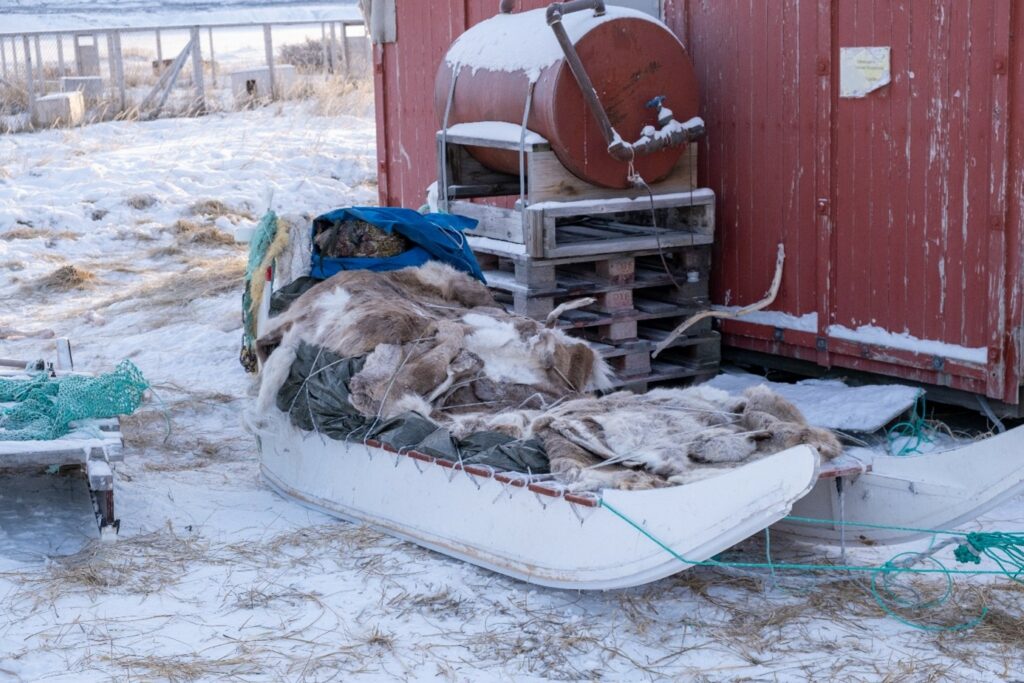
© Aurélie Hendrick, all rights reserved
My guide is checking on me regularly and spends a lot of time concentrating on his dogs, especially on untangling their lines. From time to time, he takes a long whip and lets it snake on the ground next to the sled. Every dog sled driver I have met in Greenland has a whip. Used correctly, the whip guides the dogs in the right direction, for example when crossing a dangerous passage, or to incite dogs that are slowing down the sled. The guide also carries a rope of medium thickness on his shoulder which he uses to brake when necessary (on a slope, for example), throwing it in front of him with a skilful gesture so that it slips under one of the sled’s runners.
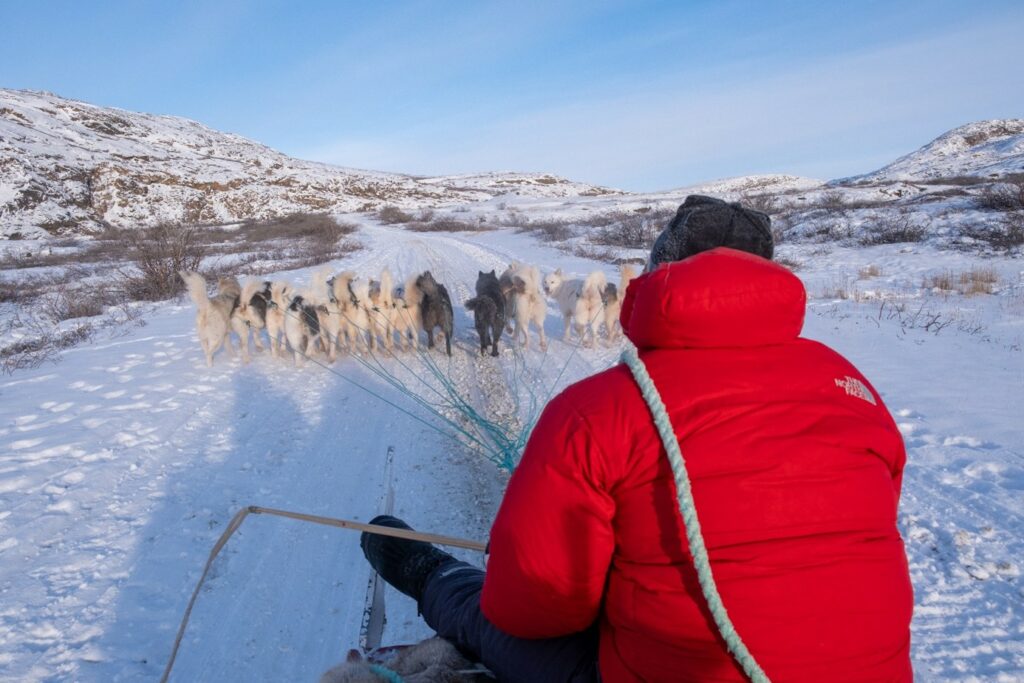
For the first few hours of our journey, my guide has pointed out the “tuttu”, the reindeer that do not seem to be too troubled by our team passing by. We take breaks, my guide worrying that the other team will not reach us. These breaks allow us to drink coffee and hot fruit juice and eat snacks. Breaks are also used to train and care for the dogs, such as checking for paw injuries.
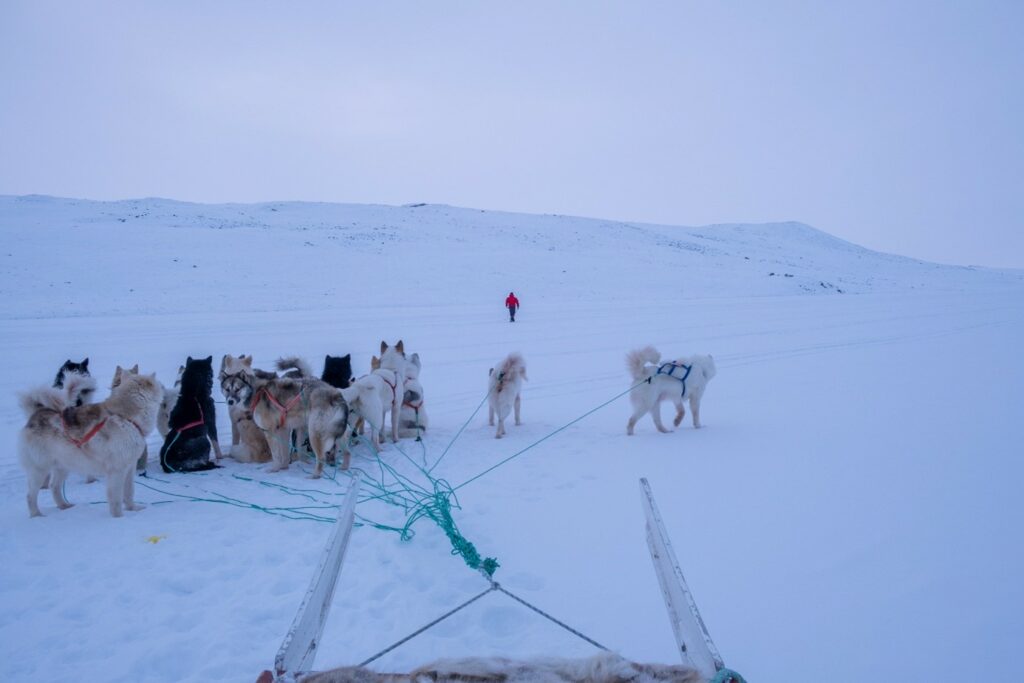
© Aurélie Hendrick, all rights reserved

© Aurélie Hendrick, all rights reserved
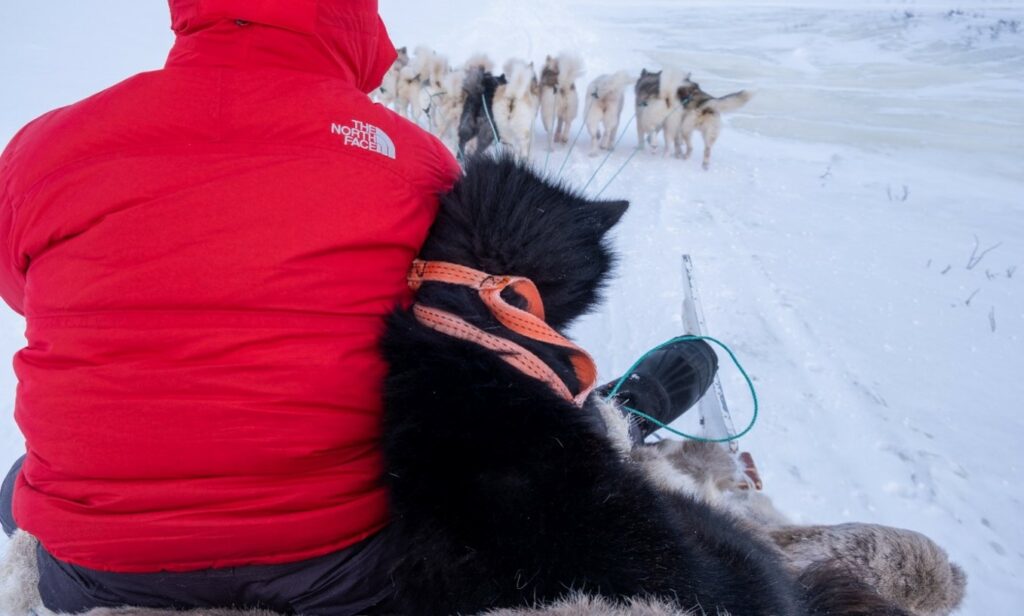
We arrive at our stop just before nightfall. Our day is not over yet, we still have to unpack the sled, heat the cabin, get some ice to melt for the meal, put the long chain on the dogs for the night, untie them and lead them one by one to their place, tie them up and take off their harness for the night. Tied up two by two, their places are not chosen at random but according to their affinities.

© Aurélie Hendrick, all rights reserved
Gradually I notice the individual places in the team that the dogs chose and that hardly changed. By taking part in the harnessing and unharnessing activities, I become aware of the temperaments of some of the dogs and the challenge for my guide to build both an individual and a collective relationship with his team. The last part of the journey involves significant differences in altitude, rougher, more mountainous landscape, we have to get off the sled to help the dogs, the climb is slow. At the top, a few metres higher, is the descent and it is dizzying sometimes! The dogs are running, my guide tells me to hold on as he uses a brake mat (it looks like a rubber grid) at the back to slow the sled down and prevent it from catching up with the dogs and running over them. The closer we get to Sisimiut, the more people we meet, other sled dog teams, hunters on snowmobiles, a lonely tourist with his pulka…
At the last stop, a poster on the toilet door announces the end of the journey and suggests places to rest, relax and eat in Sisimiut. As the night falls and the telephone network comes back on, much to the delight of my guide, who can’t wait to see his loved ones again, the cries of the village dogs herald our arrival, while at the same time announcing the end of this experience for others to come.
This excerpt is based on my field diary, which was fed by the observations I made of tourist guides and their dogs at the very beginning of my third stay on the west coast of Greenland for my thesis dissertation. For an apprentice researcher working with the ethnographic method, which is based on the direct and daily experience of the observed phenomenon, it is important to be able to experience what living beings go through on a daily basis. This is why I decided to undertake a three-day “participant observation” trip in the form of “adventure tourism” between Kangerlussuaq and Sisimiut, where I will continue my fieldwork through interviews, other observations and documentary work.
My thesis focuses on the working relationship between humans and sled dogs. I want to understand how these relationships are shaped in different ways today and what this tells us about the evolution of these relationships with so-called ‘polar’ dogs over time and space. To answer this question, I am conducting a qualitative investigation by ethnographing different working situations between humans and sled dogs in Switzerland, France and Greenland. In this context, my travelling to the west coast of Greenland from autumn 2021 aimed to conduct interviews, make observations and collect documentation, in particular from local tourist guides and their dog teams.
There are currently about 13,000 sled dogs in Greenland, compared to a human population of about 56,000. The sled dog population has more than halved since the last census at the end of the 1990s as a result of the various changes (technological, social, political, environmental, etc.) that are shaping the Greenlandic landscape today. After Nuuk, the capital, Sisimiut and Ilulissat are the most important towns in terms of demographics. In 2022 Sisimiut had around 1300 sledge dogs and Ilulissat almost 3000. Every year in the spring, local and national sled dog races are held in different places, and KNR, the national television station, broadcasts the results. Tourism is a booming industry in Greenland and especially in these two towns. Not to mention the impact of Covid, Greenland received around 85,000 international land passengers in 2022, not including cruise passengers. According to GL statistics, adventure tourism is a fast-growing form of tourism.
The sled dogs are fully integrated into this type of tourism, and several local people make it their main or secondary source of income. Some people created or revived work with the dogs thanks in part to tourism. For some people, like the couple of guides who accompanied me, a several-day sledging trip allows them to escape from the confined space-time of the urban environment. Setting up a touristic activity with the dogs would therefore allow them to meet financial needs for the dogs while at the same time satisfying an existential need: “Feeling alive”, as I heard in an interview a few days after this trip. These three days gave me a sense of what it means to care for and work with a pack of dogs that I could not have gained from interviews alone. These first days in the field were a gateway to Greenland, neither totally ‘traditional’ nor totally new. They allowed me to understand another way of feeling alive and connecting with the living through tourism practices, alongside the locals who offer this activity. For this I am very grateful to the Swiss Polar Institute for giving me a scholarship to do this fieldwork, and to my guides for their warm welcome, patience and availability, I say thank you, “qujanaq”!
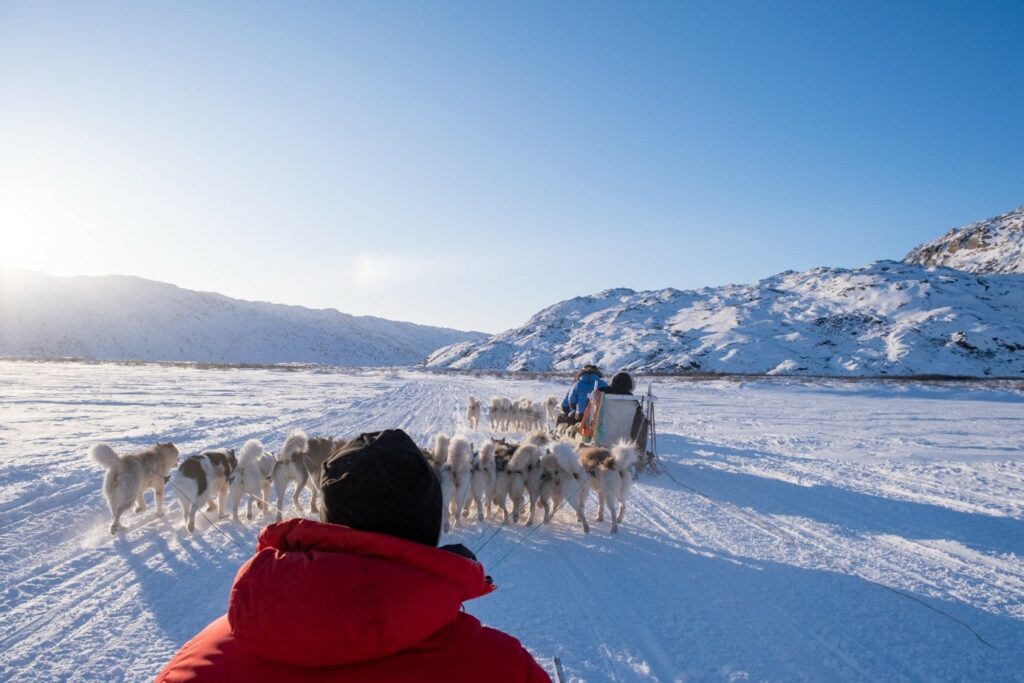
Aurélie Hendrick is a Graduate Assistant at the Institute of Geography and Sustainability at the University of Lausanne. Her fieldtrip took place in February 2023 with the financial support from a Polar Access Fund grant.
Header photograph: © Aurélie Hendrick, all rights reserved